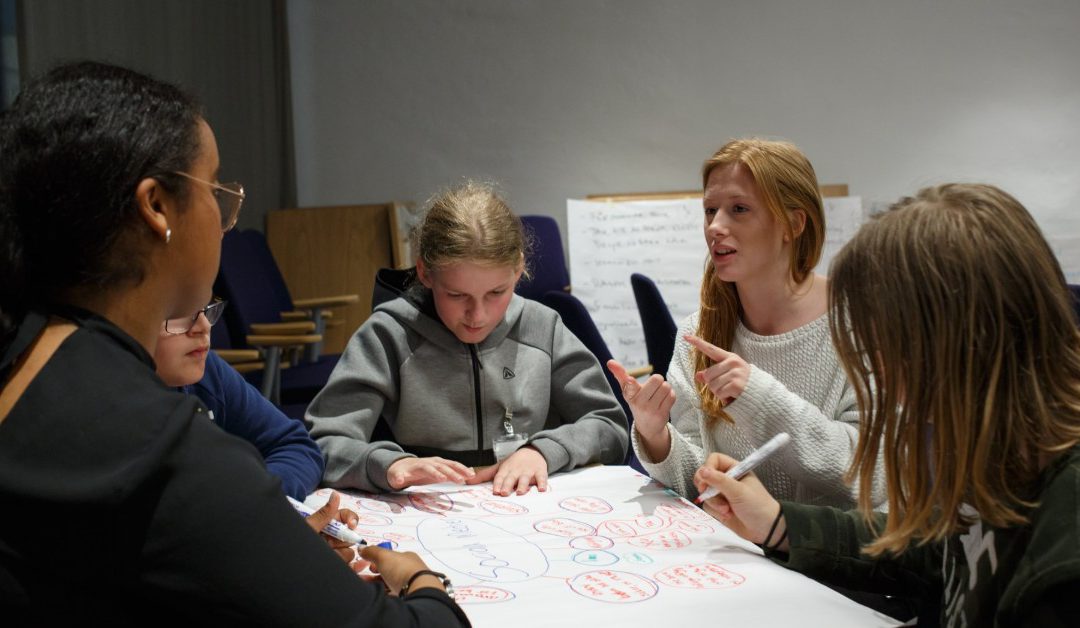The Best Soft Skills Activities for High School Students and Why They Matter
 When the nature of work is changing, the nature of learning should follow suit. While you cannot transform the entire school system overnight, you can contribute to the much-needed reformation of high schools. The activities you employ in your classroom play a crucial role in developing student agency and student leadership.
When the nature of work is changing, the nature of learning should follow suit. While you cannot transform the entire school system overnight, you can contribute to the much-needed reformation of high schools. The activities you employ in your classroom play a crucial role in developing student agency and student leadership.
To prepare your students for the future, you will need to teach them the skills that a modern-day candidate needs to possess. While hard skills are more tangible, and your students develop them to some extent through their education, soft skills are much more intricate. They are acquired through action-taking and conscious involvement—which is why your students need to learn them through activities.
Even though your school curriculum might not include the study of soft skills, you can still assign tasks that help your students develop those skills. That said, you’ll need to plan the activities well ahead before you start implementing them in your classes. Fortunately, we can help with that.

Credit: Brooke Cagle
Soft Skills vs. Hard Skills—What Is the Difference?
Hard skills refer to your ability to operate particular programs or do manual tasks that a specific profession requires. In comparison, soft skills have much to do with who you are as a person and whether you possess the personality traits employers look for in a candidate.
In the table below, you can check out some of the core distinctions between these two skill sets:
| Soft Skills | Hard skills |
| Almost synonymous with interpersonal skills | Refer to the technical skills or knowledge you possess |
| Desirable in any profession | More specific to certain job positions |
| Cannot be easily proven to your employer until you start working | A certificate or degree can prove you have the hard skills your employer seeks |
| Are acquired through varied experience, working with people, and conscious personal growth | Can be taught through training, whether in a school, college, or any type of alternative course |
To give you an example, the following abilities all fall under the category of hard skills:
- Budgeting
- Data analysis
- Computer skills
- Foreign language proficiency
- SEO
Though both types of skill sets are called for, once your students start applying for jobs, employers will place more value on soft skills because those are much harder to acquire in adulthood. For example, a worker who is inexperienced in a certain program for graphic design will get adequate training and enough time to master that hard skill. It is much more difficult to instill soft skills in someone—such as how to have a proper work ethic or collaborate with others effectively—so having them is highly appreciated.
What Constitutes Soft Skills?


Credit: Branko Stancevic
Before you start designing classroom activities that foster soft skills in students, you have to know everything that falls under this particular skill set.
Many personality traits are considered to be soft skills, and your students can develop them through interaction and experience. These skills also often overlap—which is why teaching them through interdisciplinary projects is especially effective. Here are the crucial soft skills you need to help your students develop:
- Leadership
- Flexibility
- Critical thinking
- Problem-solving
- Conflict management
- Teamwork
- Work ethic
- Emotional intelligence
Leadership Skills
Your students don’t need to strive to be future CEOs—though they shouldn’t minimize their goals too—but possessing clear leadership skills will help them in more ways than one. For example, they will be more confident:
- Expressing their voice
- Going after opportunities
- Seeking and reaching out to potential business partners
- Managing complicated projects
- Leading groups of people working on a specific assignment
Flexibility
Although adapting to change quickly might not come easily to many people, the desire and the need for new experiences are part of being human. Without that, there is no personal or professional growth.
The ability to welcome change is a valued skill in the workplace. It’s why flexibility—also called adaptability—as a skill is critical for your students to develop.
Critical Mindset
To be highly-skilled workers in any profession, your students will have to look at any notion, problem, or person from more than one perspective. When they have the competence to observe the environment around them with a critical mindset—questioning the established norms or challenging the mainstream viewpoints—they’ll be able to bring about positive change.
Problem Solving Abilities
Related to critical thinking skills are problem-solving abilities. Students need to learn how to turn complicated issues into desirable outcomes from experience.
Conflict Management
Similarly, highly-competent workers don’t panic and run from conflict when a situation in a workplace escalates. Instead, they know how to manage it with ease and confidence, rather than letting a work project or the company’s reputation suffer.
Teamwork
Employers want to hire people who thrive in collaborative projects. Thankfully, encouraging team spirit in students can be accomplished through all sorts of group projects and communal activities.
Work Ethic
Many skills and personality traits fall under the phrase work ethic. Most simply put, work ethic represents a desirable attitude and a mature approach people should have to work in general. When your students have a strong work ethic, they can:
- Honor the set appointments
- Deliver tasks within deadlines
- Manage their time and responsibilities (also known as time management skills)
Emotional Intelligence Skills
Since many soft skills are people skills, they are inevitably intertwined with having emotional intelligence (EI). There are many definitions of EI, but at its core, the notion refers to your ability to recognize where your emotions and ways of thinking come from. Being emotionally intelligent means you are willing to work on yourself constantly and detect why people around you act like they do so that you can relate to them on a more profound level.
Here are only some skills that emotionally intelligent people possess:
- Self-awareness
- Self-management
- Positivity
- Empathy
All these are, in one way or another, an asset your students need to succeed in life. For example, working on themselves brings about open-mindedness and a generally positive outlook—a trait highly valued in any workspace.
Developing empathy goes hand in hand with the ability to listen to other people carefully and detect what it is that a certain work project requires.
Self-awareness and self-management, among other things, mean your students can recognize when and why their stress levels are high and have the competence to control their behavior.
Why Is It Crucial That Your Students Develop Soft Skills?
High school is the time when your students develop the personality traits that stick with them for the rest of their lives—which is why it’s critical you teach them soft skills during that period.
Often, high school graduates find themselves overwhelmed by the amount of responsibilities college or employment brings with it. This is because traditional education systems foster rote learning and acquiring knowledge but do little to show students how to translate the skills they are being taught from the classroom into the real world.
There is a dire need to bring innovations in schools that will help students acquire theoretical knowledge and apply it to any career they choose.
The Motivation Factor in Teaching Students Soft Skills
Intrinsic and extrinsic motivation determine how well your students do in school on many levels.
Being intrinsically motivated to do a task or acquire a skill means that the activity brings personal satisfaction to your student. For example, they might like a German music band. This can then spark an interest in them to learn the German language so they can understand the song lyrics or the interviews with the band.
Extrinsic motivation implies your student wants to achieve a goal for the sake of someone or something else. For example, if they work on getting high grades because they don’t want to disappoint their parents, they are externally motivated. This type is also called instrumental motivation because your students can also be motivated to learn a particular skill so they can apply for a certain job.
The two motivation types can overlap, but you should know how to recognize and strengthen both the intrinsic and extrinsic motivation in your students.
Take special care to underline to your students that the tasks they’re doing in class help them develop their soft skills. This will boost their extrinsic motivation but can help with the internal one as well. Show them how acquiring critical thinking, time management, or self-assessment skills will not only help them become competent workers but also forge stronger relationships and feel greater personal satisfaction.
Soft Skills Activities for High School Students That You Need To Try Out


Credit: NeONBRAND
Your school curriculum likely already includes classroom activities for particular subjects that can contribute to the development of soft skills in your students. If you want them to work consciously on those activities, though, make sure you tell them why they’re important. You should also strive to actively encourage self-evaluation in your students as it’s critical for their personal growth.
Here are some ideas for classroom activities that go a long way regarding soft skills learning and how you can execute them in the right way:
- Long-term group assignment
- Argumentative presentation
- TED-Ed talks videos
- Authority over one’s homework
- Pair discussion
- Progress check
Group Assignment Activity
It isn’t uncommon for teachers to build team spirit among students by giving them group projects to work on. If you want to have a group assignment that will make your students develop soft skills, why not make it long-term?
You can ask the group to vote for a leader who will assign tasks to the group members. During a month or two that your students will have to finish the project, they are bound to face challenges in communication, problem-solving, and decision-making.
When the time comes for you to grade the project, you can have each of your students share what their task was and how they contributed to the outcome.
This activity helps your students work on their:
- Teamwork skills
- Communication and listening skills
- Conflict resolution skills
- Leadership skills
- Problem-solving skills
- Decision-making skills
- Self-assessment skills
Argumentative Presentation Activity
Argumentative essays and presentations are common in college. Why not prepare your students for their higher education by teaching them how to defend their viewpoints and challenge the opinions of others?
Here’s the breakdown of the activity:
- A pair of students are assigned an argumentative topic
- Each student prepares a speech essay to defend one side of the argument
- Your students present their viewpoints
- The class is asked which argument was more convincing
Your students will hone active listening, public speaking, and critical thinking skills through this one activity.
Argumentative topics are particularly amazing because there are so many of them. Here are some examples:
| Education | Technology | Workplace |
| Should students be made to wear school uniforms? | Technological advancement has done more harm than good. | All employees should be allowed to wear tattoos and piercings. |
| College degrees aren’t as important as they once were. | Social media made people more alienated. | Working from home cannot be a substitute for working in the office. |
| Teaching finance management should be mandatory in schools. | The development of AI will bring positive changes to society. | Companies should incorporate places for afternoon naps. |
TED-Ed Talks Video Activity
No matter what subject you’re teaching, there is bound to be at least one Ted-Ed talk video on it. You can play it in the classroom as the basis for group discussion on the topics and viewpoints expressed by a speaker.
What you can also do is assign a Ted talk video for homework and have your students relate what they’ve gathered from watching it the next class. Besides having them express whether or not they agree with the points made, you should also ask your students to think of any public speaking strategies the speaker used.
Assigning One’s Homework
If your school’s curriculum allows for flexibility, you should make use of it by giving authority to your students to assign homework to themselves from time to time. The activity fosters autonomous learning, which is a skill your students should have in any case.
Of course, you’ll want them to explain why they chose a particular homework for themselves and reflect on whether it was a good choice for the lesson it relates to.
Tell your students this practice was employed to build on their decision-making and self-assessment skills.
Pair Discussion Activity
Group your students in pairs and have them discuss various topics related to the subject or lesson you’re teaching. In contrast to the argumentative speech activity, this task should be done with a mindset to encourage empathy and listening skills in students.
When one student in the group is done talking, the other should summarize what ideas and opinions were expressed.
A bonus idea is to assign homework for which your students interview people with jobs in their surroundings. They can research how much empathy and listening skills matter in the workplace and what consequences lacking those skills can have.
Progress Check Activity
Self-evaluation is a crucial part of developing the personality traits that fall under soft skills. You can have your students start journals in which they will chronicle their progress with school obligations.
Tell them they can write whatever they want and get creative as much as they like because you won’t be checking their notes unless they show them to you.
What your students will have to do is write a self-evaluation or progress check essay in which they will answer:
- Whether they managed to complete all to-do items within the time frames they set
- What the challenges of honoring the deadlines were
- How keeping a planner helped them become aware of their strengths and weaknesses
- What they can do to improve their organizational skills
What To Keep in Mind When Doing Soft Skill Activities
Whatever task you give your students, you should keep certain points in mind with regards to developing soft skills.
To teach your students the true values of work ethic, accountability, and time management, keep in mind that giving low grades for unmet deadlines isn’t going to cut it. Make them acknowledge their failure to finish a task by having them explain why it came to that in the first place. Make sure you’re not being judgemental and show them that not having a tangible alibi is perfectly fine—what matters is that they realize they are responsible for what they do.
You should also ask them what ideas they have for mending the situation. This will teach them the importance of completing tasks in time as they are the ones who will have to compensate for any delays.
Another point to consider is how you group your students into teams. Whether you’re doing an activity with only a pair of students or larger groups, make sure the teams are diverse. Your students won’t learn to overcome the true challenges that come with collaborative projects if they work only with their close friends.
Do You Agree Soft Skills Should Be More Present in High School Activities?
If you want your students to be more engaged learners with better outcomes, you need to ensure that the impact of your classroom activities goes beyond their academic success and also improves their future job prospects. Unfortunately, traditional school curricula don’t always achieve this goal.
If you believe it’s time we transformed school culture and reformed education so it’s conducive to real-life learning, you can contribute to that mission by sharing your opinion and your expertise.
Only by working together can we have a high school education that prepares our students to reach their maximum potential and truly succeed in the modern world.

